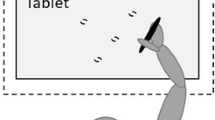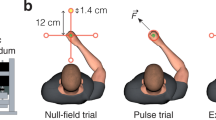Abstract
We studied intermanual motor transfer for right-to-left or left-to-right direction of transfer between either proximal or distal upper extremity muscle groups. The influence of previously acquired motor engrams (original learning, OL) on learning efficiency of the contralateral side (transfer learning, TL) was examined in 26 right-handed healthy subjects. The task consisted of the drawing of meaningless figures. During TL, OL figures had to be reproduced as vertical mirror reversals. Data revealed a benefit for right-to-left but not left-to-right direction of transfer for time to complete a figure as well as a left-to-right transfer benefit for spatial motor precision. Furthermore, a benefit for intermanual transfer of training between proximal but not distal muscle groups was found when movement time to complete a figure was evaluated. Of special interest was the observation of a disadvantage due to prior contralateral learning for performance at right distal effectors. The asymmetrical transfer benefits with respect to side are in line with previous findings and support the proficiency model and the cross-actiation model. Results further showed that intermanual transfer of training might differ with respect to muscle group involvement and suggest that, although primarily facilitating, previous opposite hand training may lead to inhibitory influences on subsequent contralateral reproduction.
Similar content being viewed by others
References
Ammons RB, Ammons CH (1951) Bilateral transfer of rotary pursuit skill. Am Psychol 6: 294
Asanuma H, Okuda O (1962) Effects of transcallosal volleys on pyramidal tract cell activity of cat. J Neurophysiol 25: 198–208
Bashore TR (1981) Vocal and manual reaction time estimates of interhemispheric transmission time. Psychol Bull 89: 352–368
Carson RG, Chua R, Elliott D, Goodman D (1990a) The contribution of vision to asymmetries in manual aiming. Neuropsychologia 28: 1215–1220
Carson RG, Elliott D, Goodman D, Dickinson J (1990b) Manual asymmetries in the reproduction of a 3-dimensional spatial location. Neuropsychologia 28: 99–103
Eacott MJ, Gaffan D (1990) Interhemispheric transfer of visuomotor conditional learning via the anterior corpus callosum of monkeys. Behav Brain Res 38: 109–116
Elliott D, Roy EA, Goodman D, Carson RG, Chua R, Maraj BKV (1993) Asymmetries in the preparation and control of manual aiming movements. Can J Exp Psychol 47: 570–589
Ferbert A, Priori A, Rothwell JC, Day BE, Colebatch JG, Marsden CD (1992) Interhemispheric inhibition of the human motor cortex. J Physiol (Lond) 453: 525–546
Fisk JD, Goodale MA (1988) The effects of unilateral brain damage on visually guided reaching: hemispheric differences in the nature of the deficit. Exp Brain Res 72: 425–435
Gould HJ, Cusick CG, Pons TP, Kaas JH (1986) The relationship of corpus callosum connections to electrical stimulation maps of motor, supplementary motor, and the frontal eye fields in owl monkeys. J Comp Neurol 247: 297–325
Guiard Y, Diaz G, Beaubaton D (1983) Eeft-hand advantage in right-handers for spatial constant error: preliminary evidence in a unimanual ballistic aimed movement. Neuropsychologia 21: 111–115
Halsband U (1992) Left hemisphere preponderance in trajectorial learning. Neuroreport 3: 397–400
Halsband U, Tanji J (1993) Cross-cultural comparison of trajectorial learning in German and Japanese subjects. Can J Neurol Sci 20: S152
Halsband U, Freund H-J, Tanji J (1991) Temporal control of movements after unilateral premotor and supplementary motor lesions in man. J Neurosci Res 16: S121
Hicks RE (1974) Asymmetry of bilateral transfer. Am J Psychol 87: 667–674
Hicks RE, Frank JM, Kinsbourne M (1982) The locus of bimanual skill transfer. J Gen Psychol 107: 277–281
Howell DC (1992) Statistical methods for psychology. Duxbury Press, Belmont, Calif, p 308
Hunter M, Ettlinger G, Maccabe JJ (1975) Intermanual transfer in the monkey as a function of amount of callosal sparing. Brain Res 93: 223–240
Jeeves MA, Simpson DA, Geffen G (1979) Functional consequences of transcallosal removal of intraventricular tumours. J Neurol Neurosurg Psychiatry 42: 134–142
Jenny AB (1979) Commissural projections of the cortical hand motor area in monkeys. J Comp Neurol 188: 137–146
Laszlo JI, Baguley RA, Bairstow PJ (1970) Bilateral transfer in tapping skill in the absence of peripheral information. J Mot Behav 2: 261–271
Levin HS, Mattson AJ, Levander M, Lindquist CEH, Simard JM, Guinto FC, Lilly MA, Eisenberg M (1993) Effects of transcallosal surgery in interhemispheric transfer of information. Surg Neurol 40: 65–74
Matsunami K, Hamada I (1984) Effects of stimulation of corpus callosum on precentral neuron activity in the awake monkey. J Neurophysiol 52: 676–691
Meyer B-U, Röricht S, Gräfin von Einsiedel H, Kruggel F, Weindl A (1995) Inhibitory and excitatory interhemispheric transfers between motor cortical areas in normal humans and patients with abnormalities of the corpus callosum. Brain 118: 429–440
Milisen R, Riper CV (1939) Differential transfer of training in a rotary activity. J Exp Psychol 24: 640–646
Myers RE, Ebner FF (1976) Localization of function in corpus callosum: tactual information transmission in Macaca mulatta. Brain Res 103: 455–462
Naito H, Nakamura K, Kurosaki T, Tamura Y (1970) Transcallosal excitatory postsynaptic potentials of fast and slow pyramidal tract cells in cat sensorimotor cortex. Brain Res 19: 299–301
Nakamura K, Naito H, Kurosaki T, Tamura Y (1971) Effect of polarizing currents on transcallosal postsynaptic potentials of cat pyramidal tract cells. Brain Res 35: 547–550
Pandya DN, Vignolo LA (1971) Intra and interhemispheric projections of the precentral, premotor and arcuate areas in the rhesus monkey. Brain Res 26: 217–233
Parlow SE, Dewey D (1991) The temporal locus of training between hands: an interference study. Behav Brain Res 46: 1–8
Parlow SE, Kinsbourne M (1989) Asymmetrical transfer of training between hands: implications for interhemispheric communication in normal brain. Brain Cogn 11: 98–113
Parlow SE, Kinsbourne M (1990) Asymmetrical transfer of Braille acquisition between hands. Brain Lang 39: 319–330
Poffenberger AT (1912) Reaction time to retinal stimulation with special reference to the time lost in conduction through nervous centres. Arch Psychol 23: 1–73
Roy EA, Kalbfleisch L, Elliott D (1994) Kinematic analysis of manual asymmetries in visual aiming movements. Brain Cogn 24: 289–295
Salmaso D, Longoni M (1985) Problems in the assessment of hand preference. Cortex 21: 533–549
Schieppati M, Musazzi M, Nardone A, Seveso G (1984) Interhemispheric transfer of voluntary motor commands in man. Electroencephalogr Clin Neurophysiol 57: 441–447
Taylor HG, Heilman KM (1980) Left-hemisphere motor dominance in right-handers. Cortex 16: 587–603
Ugawa Y, Hanajima R, Kanazawa I (1993) Interhemispheric facilitation of the hand area of the human motor cortex. Neurosci Lett 160: 153–155
Zaidel D, Sperry RW (1977) Some long-term motor effects of cerebral commissurotomy in man. Neuropsychologia 15: 193–204
Author information
Authors and Affiliations
Additional information
Part of this study was presented to the International Neuropsychological Society meeting in Angers, 1994
Rights and permissions
About this article
Cite this article
Thut, G., Cook, N.D., Regard, M. et al. Intermanual transfer of proximal and distal motor engrams in humans. Exp Brain Res 108, 321–327 (1996). https://doi.org/10.1007/BF00228105
Received:
Accepted:
Issue Date:
DOI: https://doi.org/10.1007/BF00228105




